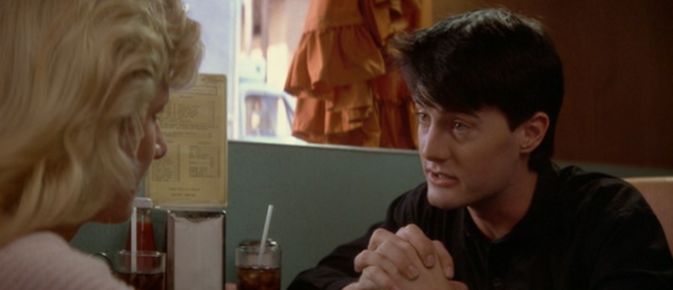 Back to selection
Back to selection
The Blue Velvet Project
Blue Velvet, 47 seconds at a time by Nicholas Rombes
The Blue Velvet Project, #23

Second #1081, 18:01
“There are opportunities in life for gaining knowledge and experience,” Jeffrey has just said to Sandy as they sit in Arlene’s.
In 1844, two years after his eldest son died of scarlet fever, Ralph Waldo Emerson began his most radical essay, “Experience,” with these sentences: “Where do we find ourselves? In a series of which we do not know the extremes, and believe that it has none. We wake and find ourselves on a stair; there are stairs below us, which we seem to have ascended; there are stairs above us, many a one, which go upward and out of sight.” Later in the essay, he directly addressed the death of his son in ways that would seem to be unthinkable in today’s culture of victim grief:
In the death of my son, now more than two years ago, I seem to have lost a beautiful estate, — no more. I cannot get it nearer to me. If tomorrow I should be informed of the bankruptcy of my principal debtors, the loss of my property would be a great inconvenience to me, perhaps, for many years; but it would leave me as it found me, — neither better nor worse. So is it with this calamity: it does not touch me: some thing which I fancied was a part of me, which could not be torn away without tearing me, nor enlarged without enriching me, falls off from me, and leaves no scar. It was caducous. I grieve that grief can teach me nothing, nor carry me one step into real nature.
Emerson’s reference to his son Waldo’s death is no lament, at least not for his son. He uses it instead to show that even this—the loss of someone he “fancied was a part of me”—could not move him “one step into real nature.” Jeffrey’s desire in Blue Velvet to be seized by reality (“experience”), to be shaken awake, to see, to feel, is an echo of Emerson’s lament. Jeffrey wants to be hurt. In order for this to happen, he must find the ear, which will lead him to Detective Williams, and then to Sandy, and then to Dorothy Vallens, and then to Frank Booth, and then finally back not to Sandy, but to Little Donny, a version of his younger self. In the frame at second #1081, Jeffrey—hands clasped together—both pleads and instructs. The narrative flow of the scene, from innocence to experience, is echoed in the frame: from light (Sandy) to dark (Jeffrey), and is just the sort of binary opposition that Blue Velvet establishes, only to destroy.
Over the period of one full year — three days per week — The Blue Velvet Project will seize a frame every 47 seconds of David Lynch’s classic to explore. These posts will run until second 7,200 in August 2012. For a complete archive of the project, click here. And here is the introduction to the project.
